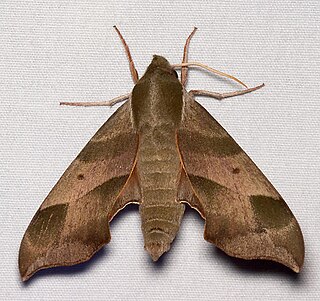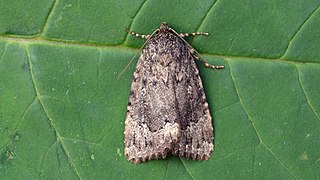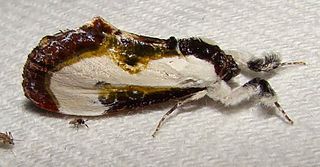
The Tortricidae are a family of moths, commonly known as tortrix moths or leafroller moths, in the order Lepidoptera. This large family has over 11,000 species described, and is the sole member of the superfamily Tortricoidea, although the genus Heliocosma is sometimes placed within this superfamily. Many of these are economically important pests. Olethreutidae is a junior synonym. The typical resting posture is with the wings folded back, producing a rather rounded profile.

Crambidae comprises the grass moth family of lepidopterans. They are variable in appearance, with the nominal subfamily Crambinae taking up closely folded postures on grass stems where they are inconspicuous, while other subfamilies include brightly coloured and patterned insects that rest in wing-spread attitudes.

The brown-tail moth is a moth of the family Erebidae. It is native to Europe, neighboring countries in Asia, and the north coast of Africa. Descriptions of outbreaks, i.e., large population increases of several years duration, have been reported as far back as the 1500s. The life cycle of the moth is atypical, in that it spends approximately nine months as larvae (caterpillars), leaving about one month each for pupae, imagos and eggs. Larvae (caterpillars) are covered in hairs. Two red spots on the back, toward the tail, distinguish these species from other similarly hairy moth larvae. The winged adults have white wings and a hairy white body with a tuft of brown hair at the tip of the abdomen. Females lay one egg cluster, usually on the underside of a leaf of a host plant. The species is polyphagous, meaning that it feeds on many different species of trees, including pear, apple, maple and oak.

The grapeleaf skeletonizer is a moth in the family Zygaenidae. It is widespread in the eastern half of the United States, and commonly noticed defoliating grapes, especially of the Virginia creeper. The western grapeleaf skeletonizer is very similar to and slightly larger than H. americana, but their distributions are different.

Hippotion celerio, the vine hawk-moth or silver-striped hawk-moth, is a moth of the family Sphingidae. It was described by Carl Linnaeus in his 1758 10th edition of Systema Naturae.

Hyles lineata, also known as the white-lined sphinx, is a moth of the family Sphingidae. They are sometimes known as the hummingbird moth because of their bird-like size and flight patterns.

Darapsa myron, the Virginia creeper sphinx, is a moth of the family Sphingidae found in central and eastern North America.

Argyrotaenia ljungiana is a moth of the family Tortricidae. It is found in Europe.

Sparganothis pilleriana, also known as the vine leafroller tortrix, is a moth of the family Tortricidae found in the Palearctic realm. It was first described by the Austrian lepidopterists Michael Denis and Ignaz Schiffermüller in 1775.

Lobesia botrana, the European grapevine moth or European grape worm, is a moth of the family Tortricidae.

Eupoecilia ambiguella, the vine moth, is a moth of the family Tortricidae. It is found in Europe, China, India, Japan, Korea, Mongolia and the Russian Far East.

Amphipyra pyramidoides, the copper underwing, is a species of moth in the family Noctuidae. It is found in the US and southern Canada.

Eudryas grata is a moth known as the beautiful wood nymph. They are known for their mimicry of bird droppings. Found in abundance, predominantly across the entire eastern United States. Hosts for the caterpillar include Ampelopsis, buttonbush, grapes, hops, and Virginia creeper.

Harrisina metallica, the western grapeleaf skeletonizer, is a species of moth of the family Zygaenidae. It is found in the Southwestern United States, from California to Texas, north to Colorado and Utah and in northern Mexico.

Ditula angustiorana, the red-barred tortrix, is a moth of the family Tortricidae found in Africa, Asia, Europe and North Africa. Other common names are the fruit-tree tortrix and the vine tortrix. The moth was first described by Adrian Hardy Haworth in 1811.

Desmia funeralis, the grape leaffolder, is a moth of the family Crambidae. It is found across the southern parts of the United States to California, north to the northeastern states and southeastern Canada.
Oxyptilus regulus is a moth of the family Pterophoridae. It is found in Australia, but has recently also been recorded from southern India.

Vitacea polistiformis, the grape root borer, is a moth of the family Sesiidae. It is found throughout the midwest of the United States, south to Florida and Texas. It is the most serious threat to grapes in Florida.

Vitacea scepsiformis, the lesser grape root borer moth, is a moth of the family Sesiidae. It is found in North America, from New York south to Florida and west to Texas, Kansas and Missouri.

Paralobesia viteana, the grape berry moth, is a moth of the family Tortricidae, found in Eastern North America and western Colorado, where it is an important agricultural pest in vineyards. The synonym Endopiza viteana is frequently used in literature, but was replaced by Paralobesia viteana per J.W. Brown (2006).




















